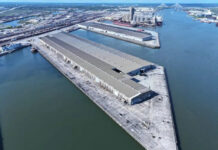
Vancouver’s Fraser Port Authority said that container throughput had increased marginally following the release its 2019 year-end statistics for cargo moving through the Port of Vancouver.
Shipping container quantities were a record 3.4 million TEU, an increase of 0.1% compared to 2018 results. While the sector is forecast to continue to grow, 2019 results reflected a number of factors including trade conflicts and shipping lines adjusting services based on market conditions.
Container trade through the Port of Vancouver is driven by Canadian demand for imports, and the resulting availability of empty containers has been essential for Canadian businesses wanting to ship goods to international markets. Approximately US$1 in every US$3 of Canada’s trade in commodities and goods beyond North America move through the port, much of it in containers.
With projected long-term growth in container trade, the port authority is leading two container terminal projects and has partnered with government and industry to invest in road and rail and other infrastructure projects to support a more fluid supply chain.
The Centerm container terminal expansion project will increase the existing terminal footprint by 15% and reconfigure terminal operations, which will increase capacity by about 65%. The proposed Roberts Bank Terminal 2 Project is a new terminal which, when complete, would add nearly 50% more container capacity to the Port of Vancouver. These projects are needed to meet the projected demand for trade of goods in containers.
With a federal mandate to make sure the port is ready to handle Canada’s growth in trade, the port authority has long taken an active role, in collaboration with government and industry, to lead and deliver a number of projects aimed at fixing bottlenecks and increasing trade network capacity throughout the region.
Overall, cargo through the port was 144 million tonnes for the year, down 2% from the 2018 record of 147 million tonnes, but the second highest in port history. Sectors that experienced declines, including foreign petroleum products and domestic forest products, were offset by record growth in other sectors including potash, grain and containers.





